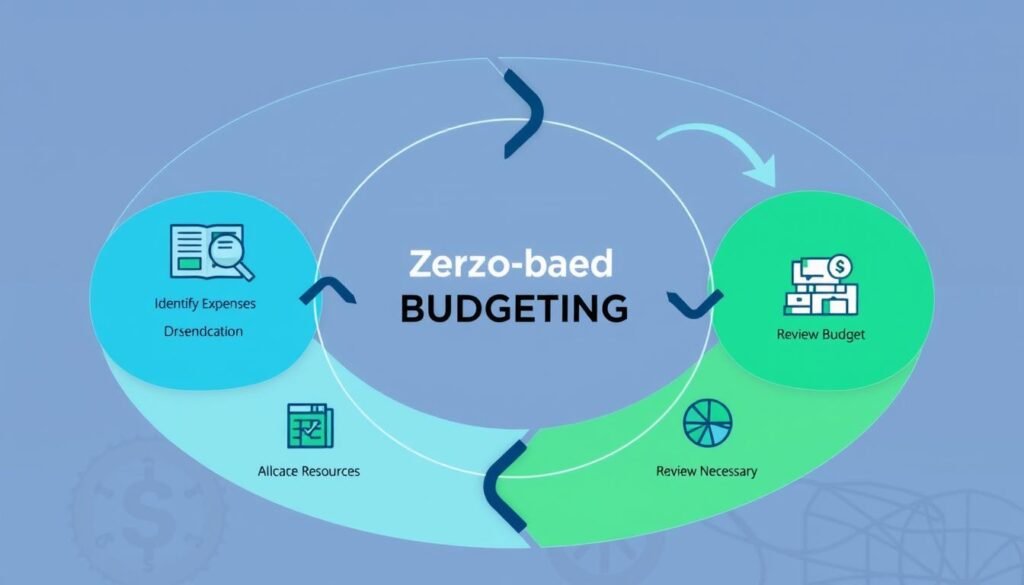Zero-based Budgeting Explained: Your Complete Guide

Zero-based budgeting starts every budget from scratch. It's different from old ways that use past budgets. This method makes sure every penny is spent on purpose.
It helps make sure money goes where it's needed most. This way, you can save more and spend less on things you don't need.
In this guide, we'll cover zero-based budgeting. We'll talk about its good points, how to start, and its uses in different areas. It's great for personal money management or for big budgets.
Key Takeaways
- Zero-based budgeting explained: Starts each budgeting period from a null base, requiring justification for all expenditures.
- Budget planning: Ensures that all expenses align with current financial goals and needs.
- Financial efficiency: Promotes cost efficiency by eliminating unnecessary spending.
- Enhanced financial control: Improves financial oversight and accountability.
- Adaptable: Can be used by businesses, individuals, and non-profits for better financial optimization.
What is Zero-based Budgeting?
Zero-based budgeting (ZBB) starts from a "zero base." It means every budget cycle begins fresh. Unlike old ways, ZBB makes you justify every expense each time.
This method looks at all costs closely. It gives deep insights into how an organization manages its money.
Definition of Zero-based Budgeting
Zero-based budgeting is a way to budget without effort. It looks at needs and costs, not just past budgets. This method makes sure money planning matches goals and checks each expense.
It helps cut waste and makes everyone think about spending wisely.
History and Evolution
Zero-based budgeting started in the 1970s in business. It then spread to government and non-profits. More places saw its value in checking expenses closely.
Comparison with Traditional Budgeting
Traditional budgeting uses old data to adjust budgets. Zero-based budgeting looks at each expense again for every new period. This makes planning money better and more accurate.
Zero-based budgeting beats the old way by checking every cost. It leads to smarter and more careful budgeting.
| Aspect | Zero-based Budgeting | Traditional Budgeting |
|---|---|---|
| Initial Budget Base | Zero base | Previous year's budget |
| Expense Justification | Required for all expenses | Typically not required |
| Cost Management Strategy | Detailed and periodic reevaluation | Incremental adjustments |
Zero-based Budgeting Benefits
Zero-based budgeting has many good points. It can really help an organization's money and how things work.
Enhanced Financial Control
One big plus is better money control. It makes sure every dollar is explained. This makes it clear where money goes.
This way, money is spent wisely. It matches with what the organization wants to do.
Cost Efficiency
It also makes spending more careful. Every expense is checked closely. This can find ways to save a lot of money.
It helps cut down on spending that's not needed. This makes things run better and more efficiently.
Improved Accountability
It also makes people more responsible with money. Every group has to explain their spending. This makes sure money is used right.
It helps save money and cuts down on waste. This makes the organization better at handling money.
The Zero-based Budgeting Process
The zero-based budgeting process helps plan finances well. It makes sure every expense is needed. This way, money is used wisely and budgets are strong.
Steps to Implement Zero-based Budgeting
To start zero-based budgeting, follow these steps. They help make a detailed financial plan:
- Define Business Goals: First, list what your business wants to achieve.
- Assess Financial Needs: Then, figure out how much money you need to reach those goals.
- Justify Expenditures: Next, explain why each expense is necessary. Only include what's really needed.
- Allocate Resources: After that, use money based on what's most important for your goals.
- Monitor and Review: Keep an eye on how money is being spent. Change plans if needed.

Common Pitfalls to Avoid
Zero-based budgeting helps manage money well, but it has its own challenges. Here are some to watch out for:
- Resistance to Change: People might not like new budgeting ways. You need to help them adjust.
- Time-Intensive Process: It takes a lot of time to go through everything. This is especially true at first.
- Lack of Expertise: If you don't know how it works, it won't be done right.
- Overemphasis on Cost Cutting: Just cutting costs can hurt your business. Think about how it affects your work too.
Knowing these problems helps. With a good plan, you can handle money issues well and keep your budget strong.
Zero-based Budgeting Examples
Zero-based budgeting is used in many places, like businesses and governments. It helps them save money and work better. This part talks about real examples of how it works.
“By deploying zero-based budgeting, Coca-Cola saved approximately $3 billion, efficiently reallocating resources from low-value to high-value activities.” — The Financial Times
In business, zero-based budgeting means checking every expense. This makes sure money is spent wisely. Big companies like Coca-Cola and Unilever have saved a lot of money this way.
Government groups also use zero-based budgeting. For example, Georgia did it to save taxpayer money. They checked every program to make sure it was needed and cost-effective.
A mid-sized retail company also used zero-based budgeting. They looked at each department's needs and cut unnecessary spending. This helped them improve their online presence and sell more online.
| Organization | Sector | Outcome |
|---|---|---|
| Coca-Cola | Business | $3 billion saved, resources reallocated |
| Unilever | Business | Enhanced cost efficiency |
| State of Georgia | Government | Improved accountability & transparency |
| Retail Company | Retail | Upgraded infrastructure & increased sales |
These examples show how zero-based budgeting helps. It makes money go further and helps businesses and governments work better. By checking every expense, they make smarter choices with their money.
Advantages of Zero-based Budgeting in Different Sectors
Zero-based budgeting (ZBB) is a smart way to plan money. It makes sure money is used for specific goals. This is different from old ways of budgeting that just change last year's numbers.
ZBB works well in many places, like business and helping others. It's good for both making money and giving to others.
Zero-based Budgeting in Business
In business, ZBB helps match spending with big goals. Every part of the company must explain why it needs money. This way, they can cut out things they don't really need.
Companies like General Electric have saved a lot of money using ZBB. They have better control over their money too.

Zero-based Budgeting for Personal Finance
For personal money, ZBB is very helpful. It lets people plan every penny they make. This way, they can save for big things or pay off debt.
It helps avoid spending on things you don't really need. And it makes choosing how to spend money easier.
Government and Non-Profit Applications
In government and non-profits, ZBB is key. It makes sure money is used right. This means taxpayers or donors get the most bang for their buck.
ZBB is also great for non-profits. It helps them focus on what really matters. This way, they can help more people.
Zero-based budgeting is good for many areas. It helps businesses, personal money, and even helping others. It makes sure every dollar is used well.
Conclusion
We've looked at zero-based budgeting in this guide. It's a smart way to manage money. It helps you plan your spending better.
Starting from zero lets you make a budget that really works. This way, you can spend money wisely. It's good for businesses, personal budgets, and even governments.
Using zero-based budgeting has many benefits. It helps you control your money better. It makes sure you spend money well.
It's important to know how to use zero-based budgeting right. But it's worth it for better money management. It helps you use your money well every day.
In short, zero-based budgeting is a smart choice. It helps you manage your money better. It's a good way to plan your finances for the future.





